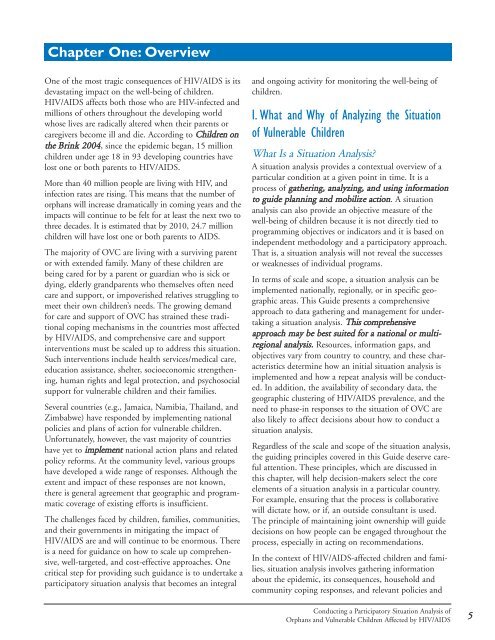Conducting a Participatory Situation Analysis of.pdf - Global HIV ...
Conducting a Participatory Situation Analysis of.pdf - Global HIV ...
Conducting a Participatory Situation Analysis of.pdf - Global HIV ...
You also want an ePaper? Increase the reach of your titles
YUMPU automatically turns print PDFs into web optimized ePapers that Google loves.
Chapter One: Overview<br />
One <strong>of</strong> the most tragic consequences <strong>of</strong> <strong>HIV</strong>/AIDS is its<br />
devastating impact on the well-being <strong>of</strong> children.<br />
<strong>HIV</strong>/AIDS affects both those who are <strong>HIV</strong>-infected and<br />
millions <strong>of</strong> others throughout the developing world<br />
whose lives are radically altered when their parents or<br />
caregivers become ill and die. According to Children on<br />
the Brink 2004, since the epidemic began, 15 million<br />
children under age 18 in 93 developing countries have<br />
lost one or both parents to <strong>HIV</strong>/AIDS.<br />
More than 40 million people are living with <strong>HIV</strong>, and<br />
infection rates are rising. This means that the number <strong>of</strong><br />
orphans will increase dramatically in coming years and the<br />
impacts will continue to be felt for at least the next two to<br />
three decades. It is estimated that by 2010, 24.7 million<br />
children will have lost one or both parents to AIDS.<br />
The majority <strong>of</strong> OVC are living with a surviving parent<br />
or with extended family. Many <strong>of</strong> these children are<br />
being cared for by a parent or guardian who is sick or<br />
dying, elderly grandparents who themselves <strong>of</strong>ten need<br />
care and support, or impoverished relatives struggling to<br />
meet their own children’s needs. The growing demand<br />
for care and support <strong>of</strong> OVC has strained these traditional<br />
coping mechanisms in the countries most affected<br />
by <strong>HIV</strong>/AIDS, and comprehensive care and support<br />
interventions must be scaled up to address this situation.<br />
Such interventions include health services/medical care,<br />
education assistance, shelter, socioeconomic strengthening,<br />
human rights and legal protection, and psychosocial<br />
support for vulnerable children and their families.<br />
Several countries (e.g., Jamaica, Namibia, Thailand, and<br />
Zimbabwe) have responded by implementing national<br />
policies and plans <strong>of</strong> action for vulnerable children.<br />
Unfortunately, however, the vast majority <strong>of</strong> countries<br />
have yet to implement national action plans and related<br />
policy reforms. At the community level, various groups<br />
have developed a wide range <strong>of</strong> responses. Although the<br />
extent and impact <strong>of</strong> these responses are not known,<br />
there is general agreement that geographic and programmatic<br />
coverage <strong>of</strong> existing efforts is insufficient.<br />
The challenges faced by children, families, communities,<br />
and their governments in mitigating the impact <strong>of</strong><br />
<strong>HIV</strong>/AIDS are and will continue to be enormous. There<br />
is a need for guidance on how to scale up comprehensive,<br />
well-targeted, and cost-effective approaches. One<br />
critical step for providing such guidance is to undertake a<br />
participatory situation analysis that becomes an integral<br />
and ongoing activity for monitoring the well-being <strong>of</strong><br />
children.<br />
I. What and Why <strong>of</strong> Analyzing the <strong>Situation</strong><br />
<strong>of</strong> Vulnerable Children<br />
What Is a <strong>Situation</strong> <strong>Analysis</strong>?<br />
A situation analysis provides a contextual overview <strong>of</strong> a<br />
particular condition at a given point in time. It is a<br />
process <strong>of</strong> gathering, analyzing, and using information<br />
to guide planning and mobilize action. A situation<br />
analysis can also provide an objective measure <strong>of</strong> the<br />
well-being <strong>of</strong> children because it is not directly tied to<br />
programming objectives or indicators and it is based on<br />
independent methodology and a participatory approach.<br />
That is, a situation analysis will not reveal the successes<br />
or weaknesses <strong>of</strong> individual programs.<br />
In terms <strong>of</strong> scale and scope, a situation analysis can be<br />
implemented nationally, regionally, or in specific geographic<br />
areas. This Guide presents a comprehensive<br />
approach to data gathering and management for undertaking<br />
a situation analysis. This comprehensive<br />
approach may be best suited for a national or multiregional<br />
analysis. Resources, information gaps, and<br />
objectives vary from country to country, and these characteristics<br />
determine how an initial situation analysis is<br />
implemented and how a repeat analysis will be conducted.<br />
In addition, the availability <strong>of</strong> secondary data, the<br />
geographic clustering <strong>of</strong> <strong>HIV</strong>/AIDS prevalence, and the<br />
need to phase-in responses to the situation <strong>of</strong> OVC are<br />
also likely to affect decisions about how to conduct a<br />
situation analysis.<br />
Regardless <strong>of</strong> the scale and scope <strong>of</strong> the situation analysis,<br />
the guiding principles covered in this Guide deserve careful<br />
attention. These principles, which are discussed in<br />
this chapter, will help decision-makers select the core<br />
elements <strong>of</strong> a situation analysis in a particular country.<br />
For example, ensuring that the process is collaborative<br />
will dictate how, or if, an outside consultant is used.<br />
The principle <strong>of</strong> maintaining joint ownership will guide<br />
decisions on how people can be engaged throughout the<br />
process, especially in acting on recommendations.<br />
In the context <strong>of</strong> <strong>HIV</strong>/AIDS-affected children and families,<br />
situation analysis involves gathering information<br />
about the epidemic, its consequences, household and<br />
community coping responses, and relevant policies and<br />
<strong>Conducting</strong> a <strong>Participatory</strong> <strong>Situation</strong> <strong>Analysis</strong> <strong>of</strong><br />
Orphans and Vulnerable Children Affected by <strong>HIV</strong>/AIDS<br />
5















